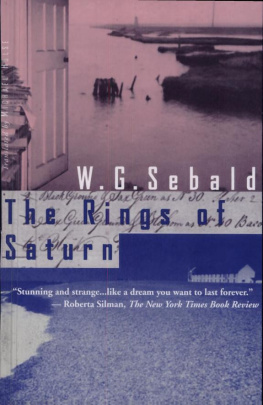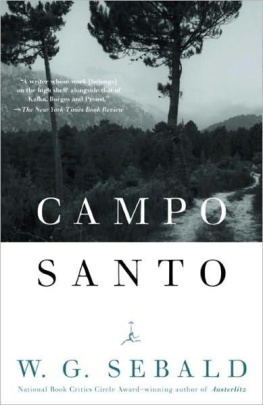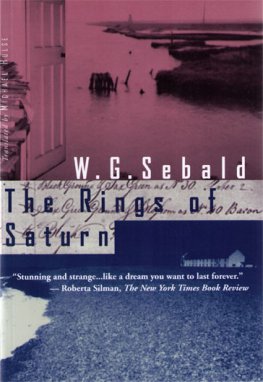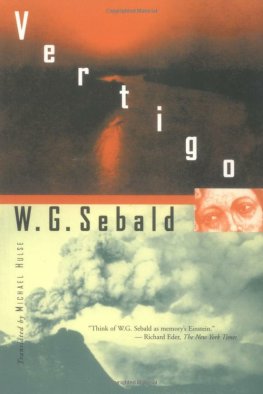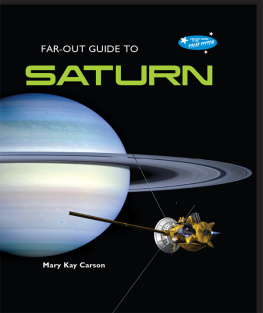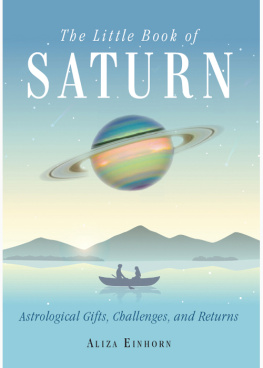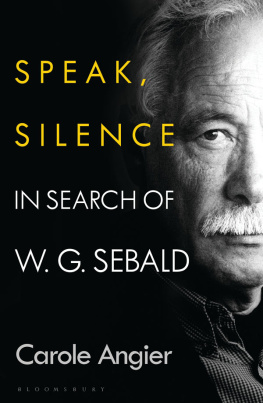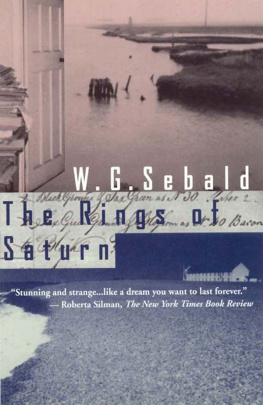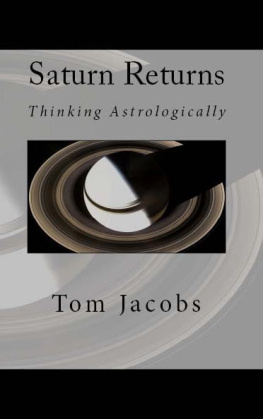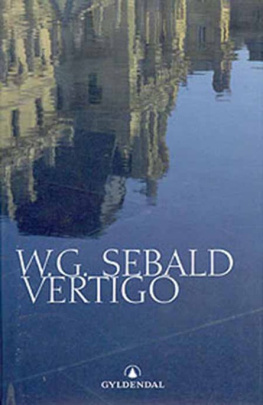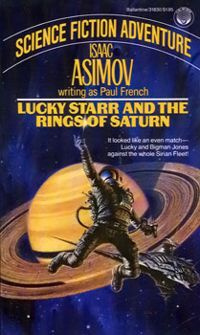
W.G. Sebald
The Rings of Saturn
Translated by Michael Hulse
Transcription by HTT.
Il faut surtout pardonner ces mes malheureuses qui ont lu de faire le plerinage pied, qui ctoient le rivage et regardent sans comprendre l'horreur de la lutte, la joie de vaincre ni le profond dsespoir des vaincus.
Joseph Conrad,
letter to Marguerite Poradowska,
23rd25th March 1890
The rings of Saturn consist of ice crystals and probably meteorite particles describing circular orbits around the planet's equator. In all likelihood these are fragments of a former moon that was too close to the planet and was destroyed by its tidal effect (Roche limit).
Brockhaus Encyclopaedia
Contents
In August 1992, when the dog days were drawing to an end, I set off to walk the county of Suffolk, in the hope of dispelling the emptiness that takes hold of me whenever I have completed a long stint of work. And in fact my hope was realized, up to a point; for I have seldom felt so carefree as I did then, walking for hours in the day through the thinly populated countryside, which stretches inland from the coast. I wonder now, however, whether there might be something in the old superstition that certain ailments of the spirit and of the body are particularly likely to beset us under the sign of the Dog Star. At all events, in retrospect I became preoccupied not only with the unaccustomed sense of freedom but also with the paralysing horror that had come over me at various times when confronted with the traces of destruction, reaching far back into the past, that were evident even in that remote place. Perhaps it was because of this that, a year to the day after I began my tour, I was taken into hospital in Norwich in a state of almost total immobility. It was then that I began in my thoughts to write these pages. I can remember precisely how, upon being admitted to that room on the eighth floor, I became overwhelmed by the feeling that Suffolk expanses I had walked the previous summer had now shrunk once and for all to a single, blind, insensate spot. Indeed, all that could be seen of the world from my bed was the colourless patch of sky framed in the window.

Several times during the day I felt a desire to assure myself of a reality I feared had vanished forever by looking out of that hospital window, which, for some strange reason, was draped with black netting, and as dusk fell the wish became so strong that, contriving to slip over the edge of the bed to the floor, half on my belly and half sideways, and then to reach the wall on all fours, I dragged myself, despite the pain, up to the window sill. In the tortured posture of a creature that has raised itself erect for the first time I stood leaning against the glass. I could not help thinking of the scene in which poor Gregor Samsa, his little legs trembling, climbs the armchair and looks out of his room, no longer remembering (so Kafka's narrative goes) the sense of liberation that gazing out of the window had formerly given him. And just as Gregor's dimmed eyes failed to recognize the quiet street where he and his family had lived for years, taking Charlottenstrae for a grey wasteland, so I too found the familiar city, extending from the hospital courtyards to the far horizon, an utterly alien place. I could not believe that anything might still be alive in that maze of buildings down there; rather, it was as if I were looking down from a cliff upon a sea of stone or a field of rubble, from which the tenebrous masses of multi-storey carparks rose up like immense boulders. At that twilit hour there were no passers-by to be seen in the immediate vicinity, but for a nurse crossing the cheerless gardens outside the hospital entrance on the way to her night shift. An ambulance with its light flashing was negotiating a number of turns on its way from the city centre to Casualty. I could not hear its siren; at that height I was cocooned in an almost complete and, as it were, artificial silence. All I could hear was the wind sweeping in from the country and buffeting the window; and in between, when the sound subsided, there was the never entirely ceasing murmur in my own ears.
Now that I began to assemble my notes, more than year after my discharge from hospital, I cannot help thinking of Michael Parkinson who was, as I stood watching the city fade into the dying light, still alive in his small house in the Portersfield Road, busy perhaps, preparing a seminar or working on his study of Charles Ramux, which had occupied him for many years. Michael was in his late forties, a bachelor, and, I believe, one of the most innocent people I have ever met. Nothing was ever further from his thoughts than self-interest; nothing troubled him quite so much as the dire responsibility of performing his duties, under increasingly adverse conditions. Above all, he was remarkable for the modesty of his needs, which some considered bordered on eccentricity. At a time when most people have constantly to be shopping in order to survive, Michael seemed to have no such need. Year in, year out, as long as I knew him, he wore either a navy blue or a rust-coloured jacket, and if the cuffs were frayed or the elbows threadbare he would sew on leather trims or patches. He even turned the collars of his shirts himself. In the summer vacations, Michael would make long walking tours of the Valais and the area around Lake Geneva, in connection with his Ramux studies, and sometimes in the Jura or the Cevnnes. It often seemed to me, when he returned from these travels or when I marvelled at the degree of dedication he always brought to his work, that in his own way he had found happiness, in a modest form that is scarcely conceivable nowadays. But then without warning last May Michael, who had not been seen for some days, was found dead in his bed, lying on his side and already quite rigid, his face curiously mottled with red blotches. The inquest concluded that he had died of unknown causes, a verdict to which I added the words, in the deep and dark hours of the night. The shock that went through us at this quite unexpected death affected no one more deeply than Janine Dakyns, who, like Michael, was a lecturer in Romance languages and unmarried too. Indeed, one might say that she was so unable to bear the loss of the ingenuous, almost childlike friendship they had shared, that a few weeks after his death she succumbed to a disease that swiftly consumed her body. Janine, who lived in a lane next to the hospital, had, like Michael, studied at Oxford and over the years had come to a profound understanding of the nineteenth-century French novel that had about it a certain private quality, wholly free of intellectual vanity and was guided by a fascination for obscure detail rather than by the self-evident. Gustave Flaubert was for her by far the finest of writers, and on many occasions she quoted long passages from the thousands of pages of his correspondence, never failing to astound me. Janine had taken an intense personal interest in the scruples which dogged Flaubert's writing, that fear of the false which, she said, sometimes kept him confined to his couch for weeks or months on end in the dread that he would never be able to write another word without compromising himself in the most grievous of ways. moreover, Janine said, he was convinced that everything he had written hitherto consisted solely in a string of the most abysmal errors and lies, the consequences of which were immeasurable. Janine maintained that the source of Flaubert's scruples was to be found in the relentless spread of stupidity which he had observed everywhere, and which he believed had already invaded his own head. It was (so supposedly once he said) as if one was sinking into sand. This was probably the reason, she said, that sand possessed such significance in all of Flaubert's works. Sand conquered all. Time and again, said Janine, vast dust clouds drifted through Flaubert's dreams by day and by night, raised over the arid plains of the African continent and moving north across the Mediterranean and the Iberian peninsula till sooner or later they settled like ash from a fire on the Tuileries gardens, a suburb of Rouen or a country town in Normandy, penetrating into the tiniest crevices. In a grain of sand in the hem of Emma Bovary's winter gown, said Janine, Flaubert saw the whole of the Sahara. For him, every speck of dust weighed as heavy as the Atlas mountains. Many a time, at the end of a working day. Janine would talk to me about Flaubert's view of the world, in her office where there were such quantities of lecture notes, letters and other documents lying around that it was like standing amidst a flood of paper. On the desk, which was both the origin and the focal point of this amazing profusion of paper, a virtual paper landscape had come into being in the course of time, with mountains and valleys. Like a glacier when it reaches the sea, it had broken off at the edges and established new deposits all around on the floor, which in turn were advancing imperceptibly towards the centre of the room. Years ago, Janine had been obliged by the ever-increasing masses of paper on her desk to bring further tables into use, and these tables, where similar processes of accretion had subsequently taken place, represented later epochs, so to speak, in the evolution of Janine's paper universe. The carpet, too, had long since vanished beneath several inches of paper; indeed, the paper had begun climbing from the floor, on which, year after year, it had settled, and was now up the walls as high as the top of the door frame, page upon page of memoranda and notes pinned up in multiple layers, all of them by just one corner. Wherever it was possible there were piles of papers on the books on her shelves as well. It once occurred to me that at dusk, when all this paper seemed to gather into itself the pallor of the fading light, it was like the snow in the fields, long ago, beneath the ink-black sky. In the end Janine was reduced to working from an easy chair drawn more or less into the middle of her room where, if one passed her door, which was always ajar, she could be seen bent almost double scribbling on a pad on her knees or sometimes just lost in thought. Once when I remarked that sitting there amidst her papers she resembled the angel in Drer's Melancholia , steadfast among the instruments of destruction, her response was that the apparent chaos surrounding her represented in reality a perfect kind of order, or an order which at least tended towards perfection. And the fact was that whatever she might be looking for amongst her papers or her books, or in her head, she was generally able to find right away. It was Janine who referred me to the surgeon Anthony Batty Shaw, whom she knew from the Oxford Society, when after my discharge from hospital I began my enquiries about Thomas Browne, who had practised as a doctor in Norwich in the seventeenth century and had left a number of writings that defy all comparison. An entry in the 1911 edition of the Encyclopaedia Britannica had told me that Browne's skull was kept in the museum of the Norfolk Norwich Hospital. Unequivocal though this claim appeared, my attempts to locate the skull in the very place where until recently I had been a patient met with no success, for none of the ladies and gentlemen of the present administrative staff at the hospital was aware that any such museum existed. Not only did they stare at me in utter incomprehension when I voiced my strange request, but I even had the impression that some of those I asked thought of me as an eccentric crank. Yet it is well known that in the period when public health and hygiene were being reformed and hospitals established, many of these institutions kept museums, or rather chambers of horrors, in which prematurely born, deformed or hydrocephalic foetuses, were preserved in jars of formaldehyde, for medical purposes, and occasionally exhibited to the public. The question was where the things had got to. The local history section of the main library, which has since been destroyed by fire, was unable to give me any information concerning the Norfolk Norwich Hospital and the whereabouts of Browne's skull. It was not until I made contact with Anthony Batty Shaw, through Janine, that I obtained the information I was after. Thomas Browne, so Batty Shaw wrote in an article he sent me which he had just published in the Journal of Medical Biography , died in 1682 on his seventy-seventh birthday and was buried in the parish church of St Peter Mancroft in Norwich. There his mortal remains lay undisturbed until 1840, when the coffin was damaged during preparations for another burial in the chancel, and its contents partially exposed. As a result, Browne's skull and a lock of his hair passed into the possession of one Dr Lubbock, a parish councillor, who in turn left the relics in his will to the hospital museum, where they were put on display amidst various anatomical curiosities until 1921 under a bell jar. It was not until then that St Peter Mancroft's repeated request for the return of Browne's skull was acceded to, and, almost a quarter of a millenium after the first burial, a second interment was performed with all due ceremony. Curiously enough, Browne himself, in his famous part-archaeological and part-metaphysical treatise, Urn Burial , offers the most fitting commentary on the subsequent odyssey of his own skull when he writes that to be gnaw'd out of our graves is a tragical abomination. But, he adds, who is to know the fate of his bones, or how often he is to be buried?
Next page
